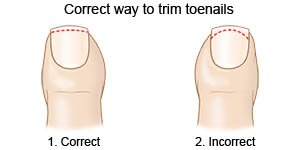Subungual Hematoma
Medically reviewed by Drugs.com. Last updated on Apr 6, 2025.
What is a subungual hematoma?
A subungual hematoma is a collection of blood under your fingernail or toenail.
What are the signs and symptoms of a subungual hematoma?
- Red or purplish blood collection under the nail
- Throbbing pain and swelling in the affected finger or toe
- Tenderness to the touch
How is a subungual hematoma treated?
- Medicines:
- Acetaminophen decreases pain and fever. It is available without a doctor's order. Ask how much to take and how often to take it. Follow directions. Read the labels of all other medicines you are using to see if they also contain acetaminophen, or ask your doctor or pharmacist. Acetaminophen can cause liver damage if not taken correctly.
- NSAIDs , such as ibuprofen, help decrease swelling, pain, and fever. This medicine is available with or without a doctor's order. NSAIDs can cause stomach bleeding or kidney problems in certain people. If you take blood thinner medicine, always ask your healthcare provider if NSAIDs are safe for you. Always read the medicine label and follow directions.
- One or more small holes may be made in your nail to drain the blood. This will help decrease pain and swelling.
- Nail removal may be done if your nail is damaged. Your healthcare provider may also need to repair the tissue under your nail.
- A splint may be placed on your finger or toe to prevent movement and protect the area while it heals.
How can I manage my symptoms?
- Apply ice on your finger or toe for 15 to 20 minutes every hour or as directed. Use an ice pack, or put crushed ice in a plastic bag. Cover it with a towel. Ice helps prevent tissue damage and decreases swelling and pain.
- Elevate your finger or toe above the level of your heart as often as you can. This will help decrease swelling and pain. Prop your finger or toe on pillows or blankets to keep it elevated comfortably.
- Gently trim your nail if it begins to fall off in pieces. This may decrease your risk for catching the nail on an object or ripping it off.

- Wear comfortable shoes that fit correctly to prevent more injury to your toe.
When should I call my doctor?
- You have increased redness, swelling, or pain.
- You notice pus or a bad smell coming from your nail.
- You see red streaks on your finger or toe that starts from your nail.
- Your nail falls off and there is bleeding.
- You have questions or concerns about your condition or care.
Care Agreement
You have the right to help plan your care. Learn about your health condition and how it may be treated. Discuss treatment options with your healthcare providers to decide what care you want to receive. You always have the right to refuse treatment. The above information is an educational aid only. It is not intended as medical advice for individual conditions or treatments. Talk to your doctor, nurse or pharmacist before following any medical regimen to see if it is safe and effective for you.© Copyright Merative 2025 Information is for End User's use only and may not be sold, redistributed or otherwise used for commercial purposes.
Further information
Always consult your healthcare provider to ensure the information displayed on this page applies to your personal circumstances.
